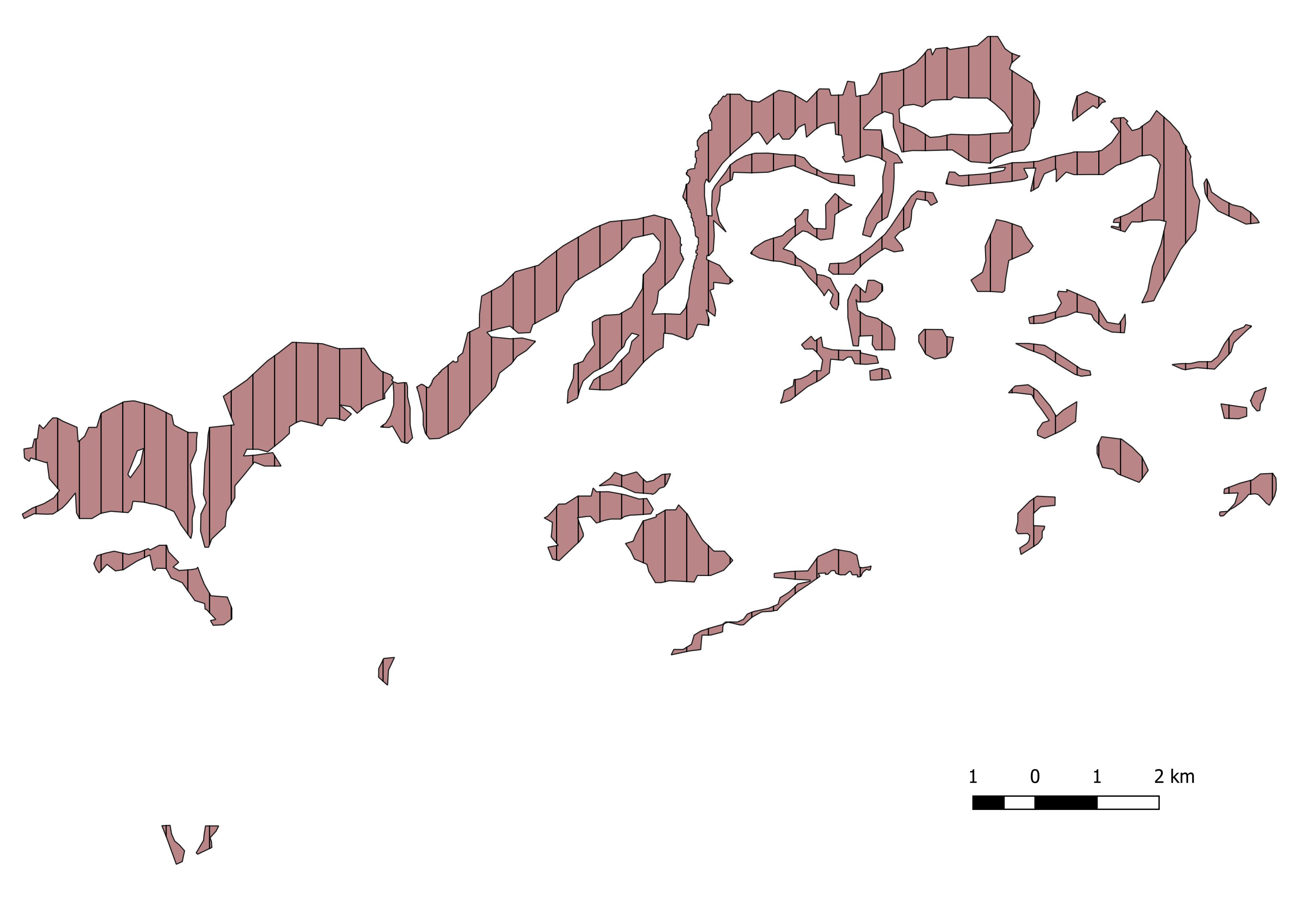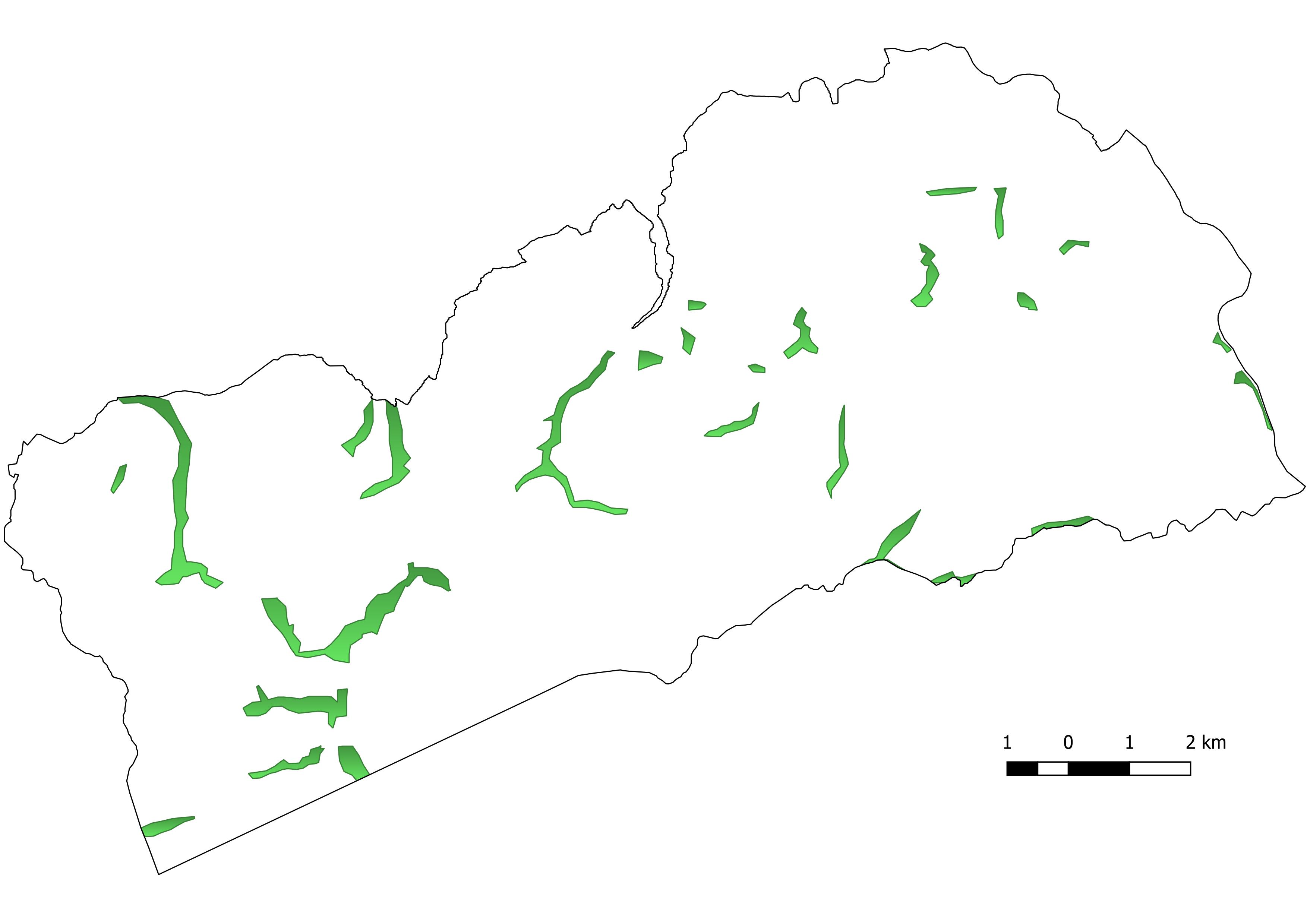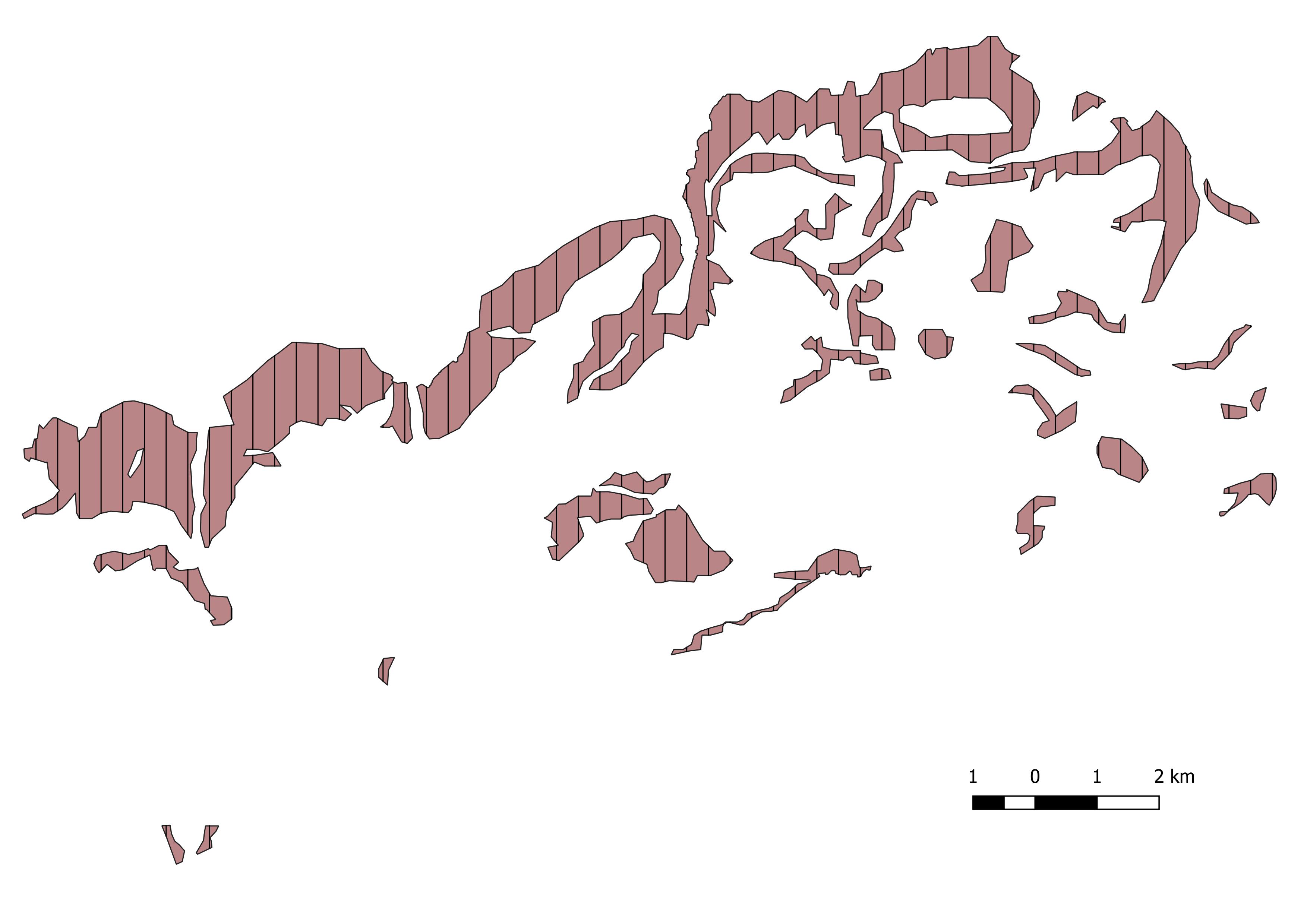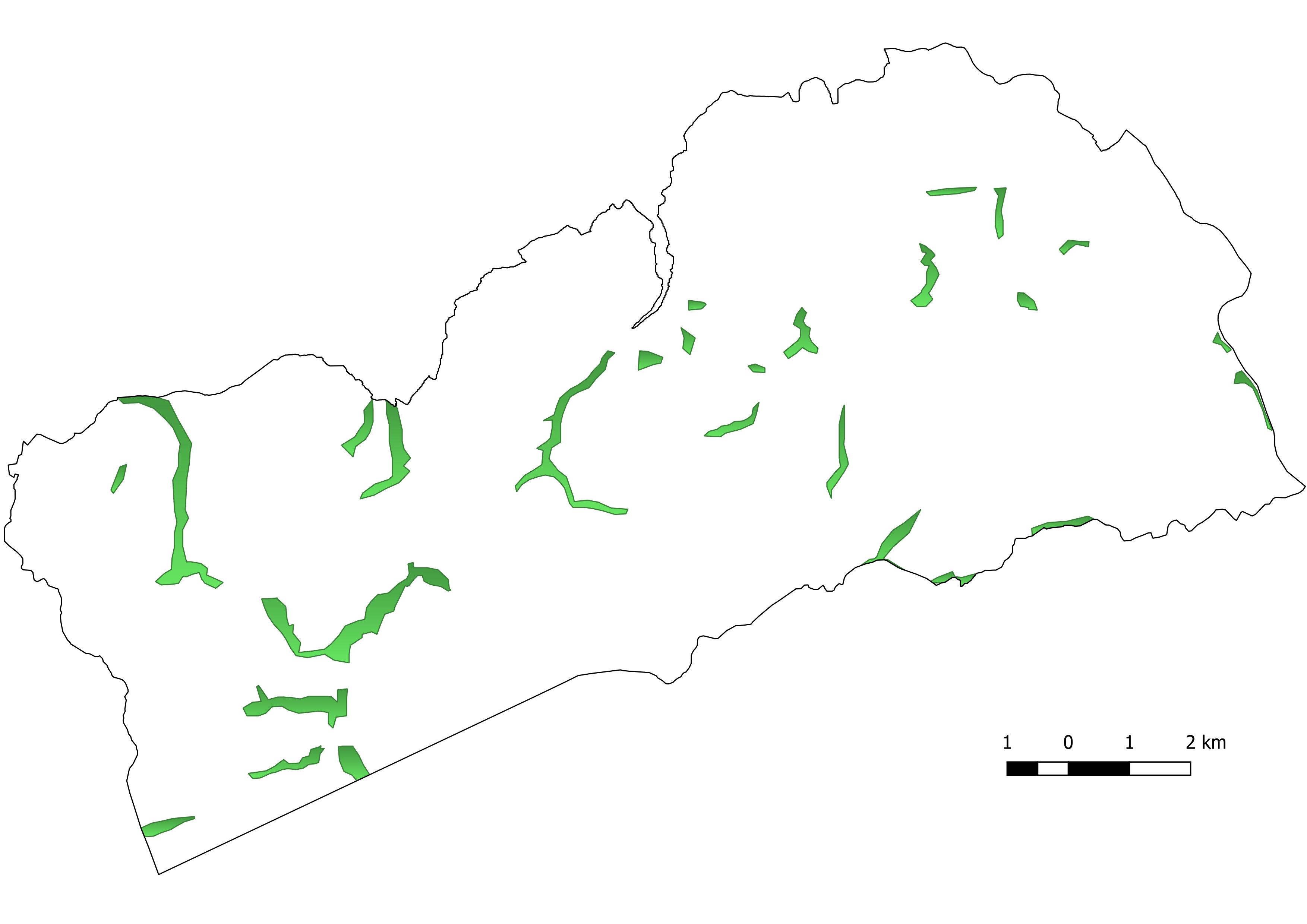Segmented transect design
Khadija Amanda Barciela
Eric Rexstad
Sent: 05 May 2023 00:50
To: distance...@googlegroups.com <distance...@googlegroups.com>; Eric Rexstad <Eric.R...@st-andrews.ac.uk>; Stephen Buckland <st...@st-andrews.ac.uk>
Subject: Segmented transect design
Khadija Amanda Barciela
Thank you for your quick reply and all the clarifications. I share with you an image of our study area to show the challenging type of fragmented stratum to be sampled. After reading your answer, we wonder if within this stratum we can have transects of different sizes. For instance, in the design proposal I share here, where I told the software for transects of 500m of length, some of them appeared merged, thus generating longer transects. Would this option be valid? If this option were possible, our second question is: could we include new transects of different shorter lengths in the areas of the layer where Distance has not placed a transect, respecting the distance between transects?

Stephen Buckland
There is no problem if lines have different lengths, provided a randomised design is used. In your case, you could have a grid of lines running north to south, and only cover the line sections that pass through the habitat of interest. That gives a simpler design, without under-sampling parts of your study area because a 500m line would not fit.
Steve Buckland
From: Khadija Amanda Barciela <amanda....@gmail.com>
Sent: Friday, May 5, 2023 1:41 PM
To: Eric Rexstad <Eric.R...@st-andrews.ac.uk>
Cc: distance...@googlegroups.com; Stephen Buckland <st...@st-andrews.ac.uk>
Subject: Re: Segmented transect design
Dear Prof. Rexstad,
Thank you for your quick reply and all the clarifications. I share with you an image of our study area to show the challenging type of fragmented stratum to be sampled. After reading your answer, we wonder if within this stratum we can have transects of different
sizes. For instance, in the design proposal I share here, where I told the software for transects of 500m of length, some of them appeared merged, thus generating longer transects. Would this option be valid? If this option were possible, our second question
is: could we include new transects of different shorter lengths in the areas of the layer where Distance has not placed a transect, respecting the distance between transects?

Thank you very much for your help. It is much appreciated.
Kind regards,
Khadija
Khadija Amanda Barciela
We would like to ask you the following, if you have time.
There are a couple of things that we would like to share with you that may be important for refining the transect design.
We are studying savanna chimpanzees and thus we will be using their nests as evidence for their presence.
Because our study area is a dry and open savanna, the chimpanzees live in extremely low population density in comparison with those living in rainforests. Additionally, the landscape of our study area is extremely fragmented. There are several vegetation types, but we know that the chimpanzees only use woodland and evergreen gallery forests.
The polygons of both woodland and gallery forests are very small, especially those of gallery forest. Only less than 4% of the landscape is gallery forest and 22% is woodland.
Our questions are the following:
1. Because it is advisable to avoid transects with zero nests when applying Distance, we are afraid that with the design you last suggested (please see attached polygons in pink below), we will be getting many small transects with no nests in woodland. We assume we will need to discard those transects were we find no nests. Is this correct? And if so, do we need to discard them before or after walking those transects?


Stephen Buckland
To: Stephen Buckland <st...@st-andrews.ac.uk>
Cc: Eric Rexstad <Eric.R...@st-andrews.ac.uk>; distance...@googlegroups.com <distance...@googlegroups.com>
Tiago Marques
--
You received this message because you are subscribed to the Google Groups "distance-sampling" group.
To unsubscribe from this group and stop receiving emails from it, send an email to distance-sampl...@googlegroups.com.
To view this discussion on the web visit https://groups.google.com/d/msgid/distance-sampling/CAL%3DxCG1UhGAX%3DXZdYEyLcm4Ji_KD9C%2BOHjbQ1MdkKd2dP%2B%2Ba_A%40mail.gmail.com.
Khadija Amanda Barciela
Thank you very much for your fast response and for the feedback that you are giving us. It is really useful.
We have two further questions, if you can afford the time.
1)
Even though we would very much like to do complete counts within the gallery forest patches, unfortunately we do not have the human resources to do that. We are afraid that the only solution we have is to place non random transects along the water courses.
If we do that, do we have to keep a minimum distance between these transects in gallery forest and the random transects in Woodland?
2)
This second question refers to the ideal transect design that you suggested (systematic random sampling of continuous transects in woodland, running north-south). We have several segments that cross very small polygons, some as small as 9 meters long. Walking every one of these very small transects will really increase the time we have available.
Would there be any way to establish a minimum transect length in this situation?
Khadija Amanda Barciela
Stephen Buckland
All I can say is that there is no statistical reason why zeros are a problem. It is normal for a survey to have zeros on some transects – it is more unusual to have a survey with no zeros. I’m copying this to Hjalmar Kühl, who may want to elaborate on the reason for his advice.
2. The polygons of gallery forests are extremely small and it was difficult to place transects within them using Distance. So we thought of an alternative method: placing transects non-randomly following the water sources within the gallery forests. We are attaching an image of the gallery forest polygons below, in green. We would like to ask you if there is any way that we can sample gallery forest using Distance. Please note that because of the topography and terrain characteristics, it is extremely difficult to follow straight transects crossing the water sources in the gallery forests.
Stephen Buckland
I don’t think you can get reliable analysis from non-random transects along the water courses. Distribution of animals will not be uniform with respect to the transects, and the transects will not cover representative habitat. If you can do a fairly complete count along a transect in that habitat, a solution might be to take a random sample of gallery forest patches, do complete counts of those, and then multiply up for total area of such patches. Or you might restrict the count to the side of the water course where the transect is, and assume that you have counted on average half the patch – which should be OK if you select the side at random. I don’t know whether that would be a practical option though.
If patches are too small that they are unlikely to have nests, you might simply exclude those patches from your study area. Even if they are used, if they cover just say 1% of total area of suitable habitat, you would only expect downward bias in your abundance estimate of about 1%.
Steve Buckland
From: Khadija Amanda Barciela <amanda....@gmail.com>
Sent: Friday, May 5, 2023 6:28 PM
To: Stephen Buckland <st...@st-andrews.ac.uk>
Cc: Eric Rexstad <Eric.R...@st-andrews.ac.uk>; distance...@googlegroups.com
Subject: Re: Segmented transect design
Dear Prof. Buckland,
2. The polygons of gallery forests are extremely small and it was difficult to place transects within them using Distance. So we thought of an alternative method: placing transects non-randomly following the water sources within the gallery forests. We are attaching an image of the gallery forest polygons below, in green. We would like to ask you if there is any way that we can sample gallery forest using Distance. Please note that because of the topography and terrain characteristics, it is extremely difficult to follow straight transects crossing the water sources in the gallery forests.




